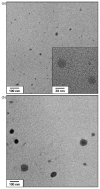Novel pH-sensitive polyacetal-based block copolymers for controlled drug delivery
- PMID: 20801203
- PMCID: PMC3006081
- DOI: 10.1016/j.ijpharm.2010.08.029
Novel pH-sensitive polyacetal-based block copolymers for controlled drug delivery
Abstract
The principal aim of this study was to synthesize and characterize pH-sensitive biodegradable triblock copolymers containing a hydrophobic polyacetal segment for controlled drug delivery. Poly(ethylene glycol)-poly(ethyl glyoxylate)-poly(ethylene glycol) (PEG-PEtG-PEG) triblock copolymers with PEG molecular weights 500 (PEtG-PEG(500)) and 750 (PEtG-PEG(750)) were synthesized by PEtG end-capping with methoxy PEG via a carbamate linkage. Synthesized amphiphilic PEG-PEtG-PEG was characterized by (1)H NMR spectroscopy. Molecular weights of PEtG-PEG(500) and PEtG-PEG(750) were determined to be 2823 and 3387, respectively, by gel permeation chromatography. The polymers with a biodegradable polyacetal block underwent pH-dependent degradation via an acid-catalyzed hydrolysis. Paclitaxel (PTX)-loaded polymeric micelles were prepared by a dialysis method and the amount of PTX incorporated into the polymeric micelle formulations was 45,000 times greater than the water solubility of PTX at room temperature. The polymeric micelles prepared from the amphiphilic PEG-PEtG-PEG triblock copolymers have released the loaded PTX in a pH-dependent manner. The novel PEtG-based amphiphilic block copolymers can find applications for targeted and controlled drug delivery to the acidic environments found in tumors and intracellular compartments.
Copyright © 2010 Elsevier B.V. All rights reserved.
Figures





References
-
- Ahn JS, Suh JM, Lee M, Jeong B. Slow eroding biodegradable multiblock poloxamer copolymers. Polym Int. 2005;54:842–847.
-
- Bae Y, Nishiyama N, Kataoka K. In vivo antitumor activity of the folate-conjugated pH-sensitive polymeric micelle selectively releasing adriamycin in the intracellular acidic compartments. Bioconjug Chem. 2007;18:1131–1139. - PubMed
-
- Belloncle B, Burel F, Oulyadi H, Bunel C. Study of the in vitro degradation of poly(ethyl glyoxylate) Polym Deg Stab. 2008;93:1151–1157.
-
- Bikram M, West JL. Thermo-responsive systems for controlled drug delivery. Expert Opin Drug Deliv. 2008;5:1077–1091. - PubMed
Publication types
MeSH terms
Substances
Grants and funding
LinkOut - more resources
Full Text Sources
Other Literature Sources

